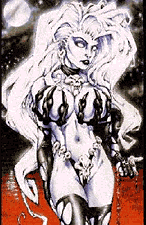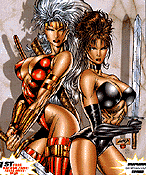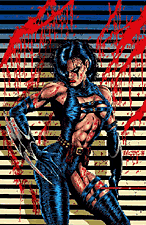
Strong Women in Comics, Part 2
Not the "Bad Girls"
The obvious question here is what do I mean by "bad girls"? They're often called "women with an attitude". Generally they are women who have been abused or had their loved ones killed, and who now seek violent vengeance clad in sexually provocative outfits -- often nothing more than a few scraps of leather and spikes -- wielding bladed weapons, occult powers or both. Frequently there is something theological or occult to their origins: demons, fallen or militant angels, vampires or fighting nuns. Artistically, they are often portrayed as women with breasts larger than either their heads or waists, with thighs as long as most women's legs, spines and leg-bones shaped like an "S", and are frequently soaked in blood.
 Lady Death |
 Glory & Avengelyne |
 Razor |
 The Bad Girls are not an entirely new phenomenon. What is new is their extremity and quantity. If we look back about twenty years we can see precursors of today's Bad Girls in Vampirella and Elektra (both of whom have experienced a rebirth as modern bad girls). Yet both of these characters were quite different from their modern sisters.
The Bad Girls are not an entirely new phenomenon. What is new is their extremity and quantity. If we look back about twenty years we can see precursors of today's Bad Girls in Vampirella and Elektra (both of whom have experienced a rebirth as modern bad girls). Yet both of these characters were quite different from their modern sisters.
While she was a vampire, Vampirella was more of an heroic figure than a dark one. She was a native of the planet Drakulon, a world whose rivers flowed with blood, and not one of the soulless undead. Although she dressed scantily, she was portrayed much more with the innocence of a 40's cheesecake model than as a dark and dangerous temptress or avenger. In many ways, Nick Knight of the TV show Forever Knight has more in common with the original Vampirella than do the modern Bad Girls.
A good case can be made that the Bad Girl trend can be traced back to Frank Miller's Elektra, just as the "grim and gritty" trend can be traced to his Dark Knight.
In her original appearance as a guest star in Daredevil, Elektra was not much different from the Golden Age Catwoman. Both were villainesses with romantic ties to the hero of the book they appeared in. Being a creation of the 80's Elektra was a more complex morally ambiguous character. She was an assassin, a killer for hire, and yet like Catwoman, she had a certain moral core. When she died at the end of the story-arc it was a tragedy in the classic sense. Her death flowed naturally and almost inevitably out of the decisions that she made. She'd once been the sort of woman that Matt Murdock could love, and we could see the sort of life she could have, if only....

Lots of comic book characters have appeared to die and yet returned for a rematch, but that would have cheapened the tragedy of Elektra's death. No, she had to have really died. That meant that for her to return she would have to be literally resurrected, which Miller did, complete with a dark ritual in a desecrated church, thus bringing in the dark metaphysical aspect so often seen among the Bad Girls. Miller and his collaborator Bill Seinkewitz also adopted the then radical and innovative approach of showing graphic violence, a move that contributed to the emergence of the "grim and gritty" vision of what constituted "realism" in comics.
When Elektra first emerged as a dark, morally troubled tragic character she was very innovative, an example of comics striving for legitimacy, borrowing standards, images and techniques from outside the confines of the rather narrow comic book tradition. Today's Bad Girls are far from innovative. What was new and edgy 10-15 years ago is now cliche. The new Bad Girls can try to be more shocking, more profane, more excessive, but there is very little new about the directions they go.
For a few other perspectives at what makes Bad Girl art, take a look at the Miss Bad Girl Art Contest,
the Devilish Comic Women page
or the Bad Girl Art Index rating system.
Also, note that occasionally comic publishers or reviewers take to calling characters like
Warrior Nun Areala or Jim Shooter's "Fatale", "Good Girls", even though they are much closer to the Bad Girl ideal than the traditional Good Girls of comics (see part 1).
|| Previous | Comics Page | JimB's Home Page | Next ||